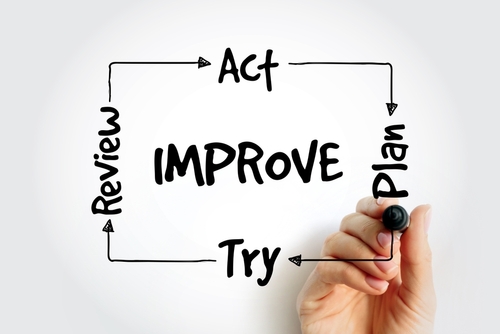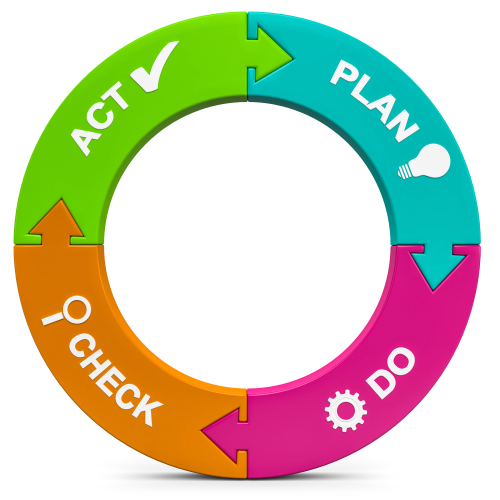6. Continuous improvement
| Site: | StudentWeb |
| Course: | 2025 Communicate and work in health or community services (VDSS_CHCCOM005) |
| Book: | 6. Continuous improvement |
| Printed by: | Guest user |
| Date: | Friday, 15 August 2025, 11:12 PM |
Description
 ▽ Show attribution
▽ Show attribution
Used under licence with shutterstock.com. Added 10/01/2024
1. What is continuous improvement?
In general terms, continuous improvement is based on the importance of continually updating, adapting and improving processes and services to ensure you are meeting the needs of your consumers, staff, organisational requirements and government regulatory agencies. Wikipedia describes continuous improvement as:Continuous improvement for the Aged Care Sector is more directed specifically at tangible outcomes and quality processes that help to govern and drive positive improvements and change. The Australian Governments Aged Care Quality and Safety Commission describes continuous improvement in the following terms:A continual improvement process, also often called a continuous improvement proccess (abbreviated as CIP or CI), is an ongoing effort to improve products, services or processes. These efforts can seek incremental improvement over time or "breakthrough" improvement all at once. Delivery (customer valued) processes are constantly evaluated and improved in the light of their efficiency, effectiveness and flexibility.
Either way, it is clear that it is a concerted and regular process that is designed to drive improvements for all involved.Continuous improvement is a systematic, ongoing effort to improve the quality of care and services. It:
- considers the needs of a provider's consumers and may involve them in improvement activities;
- is part of an overall quality system that assesses how well a provider's systems are working and the standard of care and services achieved; and
- is a results-focused activity demonstrated through outputs and outcomes.
To be effective, continuous improvement must be a provider's central focus, be understood at all levels and accepted by all management and staff.
2. Elements and benefits of continuous improvement

Key elements include:
- consumer-focused
- innovation
- achievement of improvement through planned steps
- driven by involvement and accountability of key stakeholders:
- consumers, representatives, carers and others
- staff and volunteers
- committee and board members
- advocates
- involves regular monitoring and evaluation of progress; linking evaluation to strategic planning.
Benefits of continuous improvement:
- improve care and services to consumers
- improve stakeholder input and ownership
- identify changes in care and service needs
- enhance systems to monitor and track change
- demonstrate sustainable results.
(Source: Australian Government, Aged Care Quality and Safety Commission)
2.1. Continuous improvement cycle
The model shown below is the four-phase Plan-Do-Check-Act cycle.
Step 1 - Plan
Analyse the current situation of your organisation, gather information and research different ways to make improvements. Seek input and feedback from stakeholders. Establish goals and identify actions to implement the plan. Develop the measures you will use to evaluate if the change has been effective.
Step 2 Do
- Test the suggested alternatives to identify the preferred improvement.
- Allocate resources to ensure the improvement is a success.
- Ensure that all staff involved in the change have a clear understanding of what is expected and what documentation needs to occur
- Keep your stakeholders informed and involve those with a direct benefit from the outcome.
- Document the decisions made during the implementation phase.
Step 3 Check
Evaluate if the improvement is delivering what you intended; are changes required or should an alternative improvement be used.
Measure the improvements for example, audits, assessments and surveys. Document the evaluation methods and results. Take your time; incremental steps may deliver better results.
Step 4 Act
There are two possible situations in this step:
- If the improvement isn’t successful, analyse what can be done differently next time and go through the cycle again with a different plan.
- If successful, ensure all stakeholders are informed of the new process, all necessary staff are trained and educated, policies and procedures are implemented and change within the organisation is managed.
2.2. Your role in the cycle

As a staff member and a key stakeholder in the continuous improvement process, it is an important part of your role to be actively involved in the identifying and voicing of improvements in work practises.
Continuous improvement can be applied to any activity you are required to complete.
Here are some questions that will help you to consider ways to improve processes:
- Is there a better way this activity could be done?
- How can we do it more efficiently?
- Are there any wasteful or redundant elements to this activity?
- Is the activity achieving what we want it to do?
- What would we have to do to improve the process?
If you discover or consider there is a better way to perform a routine task, it is important to bring this up with your supervisor. Any improvement no matter how minor, that improves a work practice, improves the consumer's experience and satisfies the need for health and safety is vital in the quality process.
Don't underestimate your knowledge and experience as an AHA, as you are best placed to recommend changes to processes and tasks related to your job role, because of your experience in undertaking the tasks on a daily basis.
You will have an excellent perspective and understanding of how the task can be improved.
3. Keeping yourself informed of improvements

As continuous improvement is rolled out across facilities and organisations, there is a period of time where the old way is replaced by the new way. Often times, this is conducted by clearly defined notifications, newsletters, staff meetings and if necessary training to ensure that all stakeholders are aware of the improvements and when they are to be implemented.
It is most important that when implementing these modifications or improved process that everyone understands the changes, why it is being introduced and the role they play in the implementation. Your supervisor will ensure you have all the information you need to change your practices based on the improvements implemented. For example, a simple change of moving the location of the vital piece of equipment or the location of the emergency warden items to improve the health and safety of operators will require this being communicated and discussed at a staff meeting and followed up with an email and a notice on an information board. It will also need to be incorporated into the induction program for new staff.
There will be times when changes and improvements are significant enough to warrant the re-writing of a standard operating procedure or policy. It is important that you keep abreast of these changes and implement them within the timeframe recommended.
4. Skill development

An essential element of being a skilled AHA is the process of improving your skills and knowledge and keeping up to date with current practice. This is basically about engaging in opportunities for professional development, as well as participating in a feedback process which involves the giving and receiving of feedback on skills and development.
As an AHA you will have support and supervision provided by your supervising AHP. In this relationship you will be in the position to both give and receive feedback. These tips will assist you to be actively involved in this process which will lead to positive outcomes.
Giving feedback should
- Be about behaviour not personality
- Describe the effect of the person's behaviour on you
- As specific as possible
- Timely
- At the right moment.
Receiving feedback should
- Be listened to carefully
- Reflectively questioned and clarified
- Given in a timely manner
- Listened to with self-control and not emotionally.
These skills will help you to improve your practice, and they form the basis for your personal and professional continuous improvement process.
Take a proactive approach and consult with your supervisor or manager regarding opportunities available to you to access professional development and skill training. It is important that you participate in and engage with any training that has been identified as essential to your role. This is how you stay abreast of the latest quality standards in the workplace and means your contribution as a skilled support worker is further enhanced. You are already a valued worker in the organisation, and by maintaining and updating your knowledge and skills in the industry you further improve opportunities for yourself into the future.
5. Learning activity
Learning Activity
Think about your career path including professional development once you commence working as an AHA.
Identify three ways you can continue to develop your professional skills and knowledge.